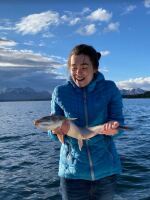Fishing has gotten off to a slow start along the Alaska Peninsula. This is particularly worrying for people who live and fish in the Chignik management area – because last summer, those communities saw the worst sockeye run since statehood.
Staff with the Alaska Department of Fish and Game began counting sockeye salmon on June 1. So far, the numbers haven’t been promising – as of today the department had counted a total of 3,374 fish.
“That’s a little slow for here. There have been years when we get off to a slow start and have a decent year. But following a year like 2018, everyone’s concerned,” said Dawn Wilburn, an area management biologist with ADF&G.
She says Chignik’s run failed to develop as predicted in 2018. Only 539,825 reds returned, and there were no commercial fishing openers.
This season, ADF&G estimates that 1.7 million fish will return, which is slightly below average. The point estimate for the early run harvest is 429,000. The late run is estimated at 571,000.
Wilburn says the department’s job will be to manage the fishery so escapement goals are met – and enough fish come back to Chignik to recover and propagate. The target escapement for June 10 is between 45,000 and 55,000 reds.
“At this point, for Chignik here we just have to wait and see how the run progresses. If it comes in strong enough with a harvestable surplus they’ll get out there and fish,” Wilburn said.
Following last year’s devastating run, much debate centered on the controversial Area M fishery, located on the south side of the peninsula just under the Perryville district.
Critics see Area M as an intercept fishery, where sockeye traveling through are harvested before they can reach fisheries closer to spawning grounds, like Chignik. But Area M fishermen feel strongly that they should be allowed to get fish however they want, arguing that it’s a traditional fishery that should be managed like any other.

Heading into the Board of Fisheries meeting in February, Chignik stakeholders hoped the board would restrict fishing in the area. To a certain extent, it did.
Of the three regulations aimed at aiding the region, one allows Chignik fishermen to start earlier in the western and Perryville districts once escapement is met. Another initiates two changes to the June salmon management plan.
The board voted to realign the setnet schedule with the drifters and seiners, creating more closure windows when no gear will be allowed in the water. The other change prohibits seiners from fishing in parts of the Dolgoi area between King Cove and Sand Point. In certain years, that area has the highest composition of Chignik-bound stocks in Area M, according to the Western Alaska Salmon Stock Identification Program, though some organizations, like the Area M Seiners Association, dispute the significance of those numbers.
These restrictions are aimed at giving Chignik fishermen more opportunity to fish and allowing more reds to pass through Area M, but some argue they don’t go far enough.
“There are 32-hour windows, so to speak, with no gear in the water,” said Axel Kopun, a Chignik fisherman and president of the Chignik Seafood Producers Alliance. “The problem is, 32 isn’t really enough to get the fish all the way through that area. So it wasn’t enough. It’s better than nothing, but ideally it would have been about 72 hours, if you look at travel time of the fish through an area.”

While Kopun fears the regulations won’t help enough if there is a repeat of last year’s run, many stakeholders in Sand Point see them as a fair approach to management.
“We’re very sympathetic to the problems that were caused last year,” said Ernie Weiss, the natural resources director for Aleutians East Borough. “[We] didn’t think it was Area M’s fault. It was a crisis all over the Gulf. The department has emergency order authority. And any reallocation of fishing opportunity in Area M would impose significant hardship on Area M fishermen and communities in exchange for minimal conservation gain.”
According to Weiss, there will be 305 hours of such closures compared to last year’s 176 hours – an increase of 72 percent.
Fishermen and managers will get a better sense of how the new sockeye regulations play out as the season gets underway.
While concern about reds is high, the pink salmon forecast for Area M is looking promising. It should be noted that ADF&G has not regularly forecast that pink salmon run. Nevertheless, with a point estimate of 20.6 million fish and a harvest range reaching 37.9 million, it’s the district’s biggest pink forecast on record.
Contact the author at isabelle@kdlg.org 907-842-2200.




